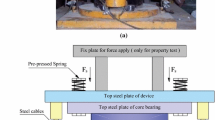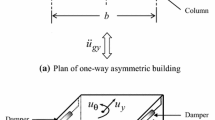Abstract
Sine sweep and earthquake excitation tests have been performed on a one-story spatial steel frame building equipped with two identical semi-active assemblies described and fully characterized in a companion paper. The tests allowed identifying and validating simple mathematical models of the building in its passive configurations as well as in semi-active operation according to an energy storing and suddenly dissipating algorithm. In order to eliminate or at least attenuate the detrimental effects of control delays due to adopted software, electronic apparatus and mechanical inertia of variable dampers' moving parts, a simple ‘sine-fit’ prediction method was conceived, evaluated and adopted in subsequent tests. It is shown that, with adequate anticipation of device operation, the selected control algorithm produces a satisfactory reduction of building response compared to that obtained in passive configurations, with overall system efficiency practically independent of the earthquake input and related only to the properties of the semi-active assembly.
Similar content being viewed by others
References
Housner, G.W., Bergman, L.A., Caughey, T.K., Chassiakos, A.G., Claus, R.O., Masri, S.F., Skelton, R.E., Soong, T.T., Spencer, Jr. B.F. and Yao, T.P. (1997) Special Issue: structural control: Past, present, and future. Journal of Engineering Mechanics ASCE 123(9), 897–971.
Inaudi, J.A. and Kelly, J.M. (1995a) Nonlinear Homogeneous Dynamical Systems, report no. UCB/EERC-93/11, University of California at Berkeley.
Inaudi, J.A. and Hayen, J.C. (1995b) Research on variable-structure systems in the United States. In Proceedings of the Post-SMiRT Conf. Sem. on Seismic Isolation, Passive Energy Dissipation and Control of Vibrations, Santiago, Chile, pp. 591–622.
Inaudi, J.A. (1996) Control of variable-damping systems. In Baratta A. and Rodellar, J. (eds), Proceedings of the 1st European Conference on Structural Control, Barcelona, Spain, pp. 362–369, World Scientific, Singapore.
Inaudi, J.A. (2001) Performance of variable damping systems: theoretical analisys and simulation. In Structural Control for Civil and Infrastructure Engineering, World Scientific, Singapore, pp. 301–316.
Kurata, N., Kobori, T., Takahashi, M., Ishibashi, T., Niwa, N., Tagami, J. and Midorikawa, H. (2000) Forced vibration test of a building with semi-active damper system. Earthquake Engineering and Structural Dynamics 29, 629–645.
Luenberger, D.G. (1979) Introduction to Dynamic Systems. John Wiley & Sons: New York, pp. 394–416.
National Instruments (1998) LabView 5.0 Reference Manual. National Instruments Corporation: Austin, Texas, 1998.
Nishitani, A. (2001) Semiactive structural control strategy for buildings against severe earthquakes. In Structural Control for Civil and Infrastructure Engineering, World Scientific, Singapore, pp. 407–413.
Occhiuzzi, A. and Serino, G. (1996) Energy criteria for application and use of active switching control devices. In Baratta A. and Rodellar, J. (eds), Proceedings of the 1st European Conference on Structural Control, Barcelona, Spain, pp. 475–482, World Scientific, Singapore.
Occhiuzzi, A. and Serino, G. (2000) Earthquake excitation tests on a prototype semi-actively controlled structure. In Proceedings of the 2nd European Conference on Structural Control, Paris, France, in press.
Patten,W.N., Mo, C., Kuehn J. and Lee J. (1998) A primer on design of semiactive vibration absorber (SAVA). Journal of Engineering Mechanics ASCE 124(1), 61–68.
Patten, W.N., Sun, J., Li, G., Kuehn, J. and Song, G. (1999) Field test of an intelligent stiffener for bridges at I-135 Walnut Creek Bridge. Earthquake Engineering and Structural Dynamics 28, 109–126.
Serino, G. and Georgakis C.T. (1999) Response prediction methods for semi-active control of structures. In Proceedings of the 4th International Conference of the European Association for Structural Dynamics (EURODYN’ 99), Pragua, Czech Republic, Vol. 1, pp. 109–114.
Serino, G., Occhiuzzi, A., Georgakis, C. (2001) Experimental study and perspectives of semi-active oleodynamic devices for seismic protection of structures. In Franchioni, G., (ed), Experimental investigations on semi-active and passive systems for seismic risk mitigation-ECOEST2/ICONS report, LNEC, Portugal.
Serino. G. and Occhiuzzi, A. (2003) A semi-active oleodynamic damper for earthquake control. Part 1: Design, manifacturing and experimental analysis of the device. Bulletin of Earthquake Engineering 2.
Slotine, J.J., Li W. (1991) Applied Nonlinear Control. Prentice Hall: New Jersey, pp. 40–94 and 276–309.
Spencer, B.F. (2000) Advanced in semi-active control of civil engineering structures. In Proceedings of the 2nd European Conference on Structural Control, Paris, France, in press.
Symans, M.D. and Costantinou, M.C. (1997) Seismic testing of a building structure with a semiactive fluid damper control system. Earthquake Engineering and Structural Dynamics 26, 759–777.
Author information
Authors and Affiliations
Corresponding author
Rights and permissions
About this article
Cite this article
Occhiuzzi, A., Serino, G. A Semi-active Oleodynamic Damper for Earthquake Control. Part 2: Evaluation of Performance through Shaking Table Tests. Bulletin of Earthquake Engineering 1, 241–273 (2003). https://doi.org/10.1023/A:1026336809041
Issue Date:
DOI: https://doi.org/10.1023/A:1026336809041




